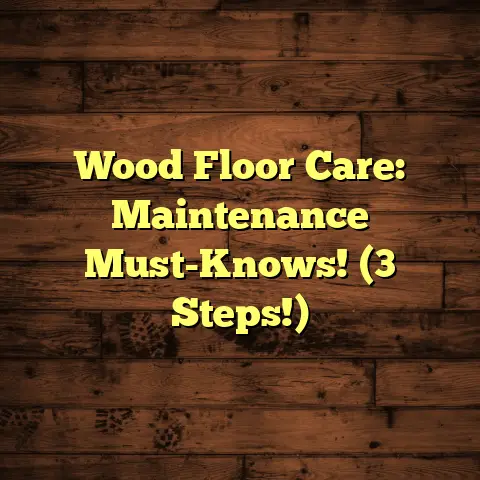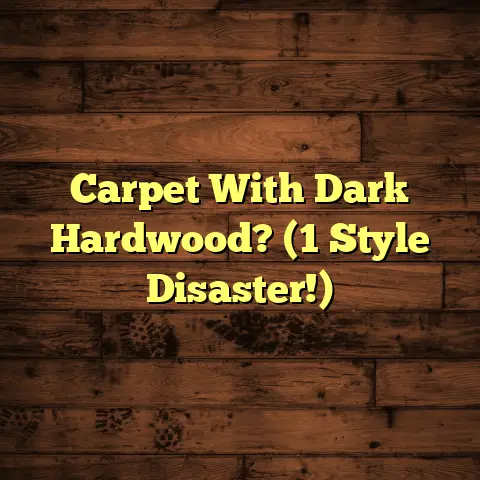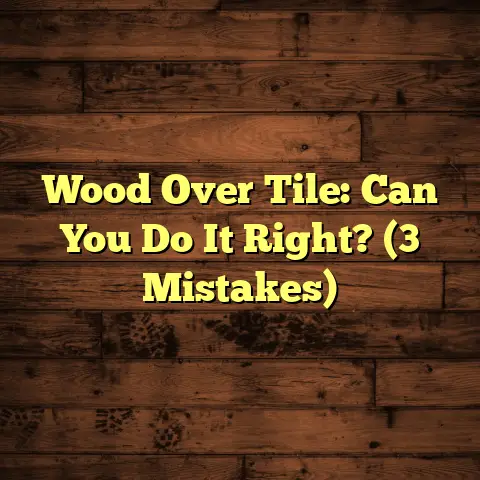Laminate Floors That Look Like Hardwood: Stylish & Budget-friendly? (Explained)
“I never thought I could have the beauty of hardwood floors without the hefty price tag,” a client once told me.
This sentiment resonates with so many homeowners who crave the warmth and elegance of hardwood but are held back by budget constraints.
That’s where laminate floors that mimic hardwood come into play, offering a stylish and affordable solution without compromising on aesthetics.
The Appeal of Laminate Floors
One of the most striking aspects of laminate flooring is its ability to closely resemble hardwood.
When I first started working with laminate, I was amazed at how authentic some of the patterns and textures looked.
The technology behind laminate has come a long way, and today, you can find options that feature intricate grain patterns and rich colors, making it tough to tell the difference between laminate and real wood.
Personal Experience with Laminate Flooring
I recall one project that involved a family who wanted to renovate their living room.
They were drawn to the look of rich oak but were worried about the cost and maintenance associated with hardwood.
After discussing their options, we decided to go with a high-quality laminate that mimicked oak.
The transformation was stunning!
The installation process took about two days, and the family was thrilled with the outcome.
It provided them with a beautiful, warm space without the financial strain.
However, it wasn’t all smooth sailing.
We encountered some challenges when it came to the subfloor preparation, as it needed to be perfectly level for the laminate to perform well.
Cost Considerations
When planning for flooring projects, cost is always a major factor.
Laminate is generally more budget-friendly than hardwood, but it’s essential to get accurate estimates.
For my projects, I often rely on FloorTally.
It helps me pull local material and labor rates, ensuring that my clients receive realistic budgets from the start.
For instance, in that living room project, the cost of the laminate planks was around $3 per square foot, while installation would add an additional $1.50 per square foot.
Overall, we managed to keep the entire project under $2,000 for a space that measured about 600 square feet.
Hidden Costs to Watch For
While laminate is cost-effective, there are hidden costs that can crop up.
For example, if the subfloor needs repair or leveling, that can add to your total expense.
Always factor in costs for underlayment and potential trim work as well.
In my experience, having a comprehensive view of all potential costs upfront helps avoid surprises down the road.
Installation Insights
Laminate flooring is known for its relatively easy installation process.
Most products come with a click-lock system that allows for a floating installation, which means no glue or nails are necessary.
This method not only speeds up the installation but also makes it easier to replace planks if needed.
However, I’ve learned that proper acclimatization of laminate planks is crucial.
I typically recommend letting the planks sit in the room where they’ll be installed for at least 48 hours.
This helps them adjust to the humidity and temperature, reducing the chances of warping or buckling after installation.
Challenges During Installation
One challenge I faced during a project was dealing with door frames.
We had to cut around them carefully to ensure a clean fit without compromising the integrity of the flooring.
Using a jamb saw helped achieve a precise cut without damaging adjacent walls or flooring.
Another challenge I encountered involved transitioning between different flooring types—specifically when moving from laminate to tile or carpeted areas.
Ensuring that these transitions are seamless required careful measurement and selection of appropriate transition strips.
Maintenance of Laminate Floors
Maintaining laminate floors is straightforward, which is another reason many homeowners love them.
Regular sweeping and occasional mopping with a damp cloth are usually all that’s needed.
I always advise my clients against using harsh chemicals or steam cleaners, as they can damage the surface.
Tips for Keeping Laminate Looking Great
- Use Area Rugs: Place rugs in high-traffic areas to protect the laminate from scratches.
- Avoid Excess Water: While laminate is water-resistant to some extent, it’s not waterproof.
Wipe up spills promptly. - Regular Cleaning: Use a soft broom or vacuum designed for hard surfaces to keep dust and dirt at bay.
- Furniture Pads: Attach felt pads to furniture legs to prevent scratches when moving items around.
- Seasonal Maintenance: During seasonal changes, humidity levels can fluctuate significantly.
It’s wise to monitor your home’s humidity and adjust as needed to prevent any potential warping.
The Look vs. Reality
While laminate can look stunningly like hardwood, there are differences in feel and sound.
When walking on high-quality laminate, it can often sound hollow compared to solid wood.
However, many homeowners find this trade-off acceptable given the significant savings.
Comparing with Other Options
I’ve worked with engineered hardwood in some projects as well.
While it offers a genuine wood surface and can be refinished, it comes at a higher cost than laminate.
In contrast, laminate is significantly more resistant to scratches and dents due to its durable wear layer.
In a recent project where a family had pets, we opted for laminate over engineered hardwood due to its resilience against wear and tear.
The clients were overjoyed with how well it held up against their pets’ playful antics!
Technical Specifications
Many modern laminates come with advanced features like anti-microbial coatings and enhanced moisture resistance.
For example, some brands offer waterproof laminate that can withstand spills from kids or pets without warping—definitely something I recommend for busy households.
When choosing laminate, look for products with a high AC rating (Abrasion Class).
A rating of AC3 is suitable for residential use, while AC4 or AC5 can handle light commercial applications.
Making Smart Choices
When selecting laminate flooring, consider:
- Thickness: Thicker planks tend to feel sturdier underfoot and provide better sound insulation.
- Finish: Opt for matte finishes over glossy ones to hide scratches and wear more effectively.
- Brand Reputation: Research brands known for quality and durability; some manufacturers offer better warranties than others.
The Manufacturing Process
The process of creating laminate involves several steps:
- Wear Layer: A clear protective coating is applied on top, which gives durability against scratches and stains.
- Design Layer: This layer features the printed design that mimics wood grain or other materials.
- Core Layer: Typically made from high-density fiberboard (HDF), this layer provides stability.
- Backing Layer: Finally, a backing layer is added for moisture resistance and structural integrity.
Understanding these layers can help you choose higher-quality products that will stand up better over time.
Environmental Considerations
As more homeowners become eco-conscious, it’s essential to consider the environmental impact of flooring choices.
Many laminate manufacturers now use sustainable practices and materials sourced from responsibly managed forests.
When discussing options with clients, I often highlight brands that have certifications such as FSC (Forest Stewardship Council) or GREENGUARD Gold certification, indicating lower emissions and safer indoor air quality.
Longevity and Sustainability
While laminate doesn’t have the same lifespan as solid hardwood (which can last decades), quality laminates can still provide many years of service—often 15-25 years—if properly maintained.
Recycling options are also becoming more available as manufacturers recognize the need for sustainable disposal methods at the end of a product’s life cycle.
Style Choices and Trends
The world of interior design is ever-evolving, and laminate flooring is no exception.
Nowadays, you can find an array of styles—from traditional oak finishes to contemporary gray tones that align with modern aesthetics.
Popular Trends in Laminate Flooring
- Wide Plank Designs: Wider planks are gaining popularity as they create a more spacious feel in rooms.
- Textured Finishes: Embossed textures add depth and realism to laminate floors.
- Neutral Colors: Gray and beige tones are trending as they complement various decor styles.
- Vintage Looks: Distressed finishes that mimic reclaimed wood are also in demand among homeowners looking for character.
Choosing the Right Laminate for Your Space
Selecting the right laminate involves considering factors such as foot traffic, room usage, and personal style preferences.
Foot Traffic Considerations
High-traffic areas like hallways or living rooms may benefit from thicker laminates with higher AC ratings for added durability.
On the other hand, low-traffic areas like bedrooms might not require such robust options.
Room Usage
Consider how each room will be used when selecting your flooring:
- Kitchens: Look for water-resistant options due to spills.
- Living Rooms: Choose styles that align with your decor preferences while providing durability.
- Basements: Opt for laminates designed specifically for lower humidity environments if you’re finishing a basement space.
Installation Techniques
While many homeowners opt for professional installation due to precision requirements, some choose DIY approaches to save on costs.
DIY Installation Tips
If you’re considering installing laminate yourself:
- Preparation Is Key: Ensure your subfloor is clean, dry, and level before starting.
- Invest in Tools: A good saw (like a miter saw) will make cutting planks easier.
- Follow Manufacturer Instructions: Each product may have specific guidelines you’ll want to adhere to for warranty purposes.
- Take Your Time: Don’t rush through measurements; accuracy is critical in achieving a professional finish.
Troubleshooting Common Issues
Despite the relative ease of installation, issues can arise.
Here are some common problems I’ve encountered along with solutions:
Gaps Between Planks
If gaps appear between planks after installation:
- Humidity Changes: Fluctuations in humidity can cause expansion or contraction; consider using a humidifier in dry seasons.
- Improper Acclimatization: Ensure planks have acclimated properly before installation.
Warping or Buckling
If you notice warping or buckling:
- Moisture Issues: Check for leaks or excess moisture beneath your flooring.
- Poor Installation Practices: Ensure no nails were used during installation since this restricts natural movement.
Scratches or Dents
For scratches:
- Repair Kits: Many manufacturers offer repair kits that include markers or fillers designed for minor surface damage.
- Preventative Measures: Use rugs in high-traffic areas and furniture pads under heavy items.
Real-Life Case Studies
Let me share some real-life scenarios where laminate floors were the perfect choice:
Family Home Renovation
In one project, a family wanted an upgrade from their worn carpet to something more durable yet stylish.
We chose a dark walnut laminate that transformed their space beautifully while standing up against their children’s foot traffic and their dog’s rambunctious activity.
The project took about four days from start to finish, including removing old carpet and preparing the subfloor.
The end result was stunning—rich tones that added warmth to their home without overwhelming their budget.
Small Apartment Makeover
I also worked on a small apartment where the homeowner desired an open feel without sacrificing style.
We opted for light gray wide plank laminate flooring which made the space look more expansive while complementing their modern furniture.
The client was ecstatic about how easy maintenance was compared to their previous flooring options!
Final Thoughts on Laminate Flooring
Choosing laminate floors that look like hardwood can be an excellent decision for many homeowners looking to balance style with affordability.
With careful planning and consideration regarding costs, installation methods, maintenance tips, and personal style preferences—you can achieve a beautiful aesthetic without breaking the bank.
Engaging in this journey of selecting new flooring doesn’t have to be overwhelming; instead, it can be an exciting transformation!
Should you have questions about specific products or installation techniques as your project progresses, feel free to reach out!
My experiences in this field have equipped me with plenty of insights I’d love to share with you!





